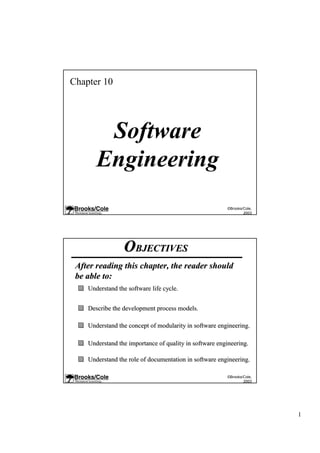
Software eng imp
- 1. Chapter 10 Software Engineering ©Brooks/Cole, 2003 OBJECTIVES After reading this chapter, the reader should be able to: Understand the software life cycle. Describe the development process models. Understand the concept of modularity in software engineering. Understand the importance of quality in software engineering. Understand the role of documentation in software engineering. ©Brooks/Cole, 2003 1
- 2. 10.1 SOFTWARE LIFE CYCLE ©Brooks/Cole, 2003 Figure 10-1 System life cycle ©Brooks/Cole, 2003 2
- 3. Figure 10-2 System development phases ©Brooks/Cole, 2003 System Development: 4 Phases • Analysis phase: – Requirements that the packages should accomplish. – 4 steps: • Define the user – Accounting package: For any firm – Customized banking package: For a specific bank • Define the needs – The best answers come from the users. • Define the requirements – Based on the users’ needs. Define system requirements. • Define the methods. ©Brooks/Cole, 2003 3
- 4. System Development: 4 Phases • Design Phase: – How the systems will accomplish what was defined in analysis phase. – OS, files and databases are determined. – Modularity – Divide the package into small modules. – Link through a main program. – Tools – Like structure chart. ©Brooks/Cole, 2003 System Development: 4 Phases • Implementation Phase: – Create actual programs. – Tools: • Flowchart, and Pseudocode. – Coding • Test Phase – Specialists: test engineers. – Two kind of tests • Black box testing • White box testing ©Brooks/Cole, 2003 4
- 5. System Development: 4 Phases • Black box testing: – Test without knowing how it works. – Test according to package requirements. • White box testing: – Know everything about the program – Programmer’s responsibility. • Testing plans in design stages • Eye toward tests for flowcharts and pseudocodes. ©Brooks/Cole, 2003 10.2 DEVELOPMENT PROCESS MODELS ©Brooks/Cole, 2003 5
- 6. Figure 10-3 Waterfall model One phase can’t be started until the previous phase is finished. Advantage: Each phase is completed before the next phase start. So the next phase exactly know what to do. Disadvantage: When locating a problem, the entire process should be investigated. ©Brooks/Cole, 2003 Figure 10-4 Incremental model A simplified version Add details… Begin with main module Each time add a new module Don’t go to next step until the previous version works properly. ©Brooks/Cole, 2003 6
- 7. 10.3 MODULARITY ©Brooks/Cole, 2003 Modularity • Definition: Break a large project into small parts that can be understood and handled. • Two tools: – Structure chart: procedural programming • An example is given in later slide. – Class diagram: Object oriented programming • Two measure for modularity – Coupling: Data relation – Cohesion: Process relation ©Brooks/Cole, 2003 7
- 8. A Simple Example for Structure Chart and Data Flow ©Brooks/Cole, 2003 Coupling • Definition: Measure of how tightly two modules are bounded to each other. • Independent modules are prefer Loosely coupled • Code reusable • Less likely to create errors. • Easy to maintain – Data coupling • Only passed min. required data to the called function. – Stamp coupling • Send the composite object (like array) to the called function. • Send extra data might result in errors or side effects. ©Brooks/Cole, 2003 8
- 9. Coupling – Control coupling • Pass the flag that direct the logic flow of a function. • Used to communicate the status. – Global coupling • Use global variables to communicate among functions. • When changing the program, not impossible to isolate the impact. • Functions are not easily reused in other programs. – Content coupling • One function refers directly to the data or statements in another one. • Break structure programming ©Brooks/Cole, 2003 Cohesion • Def: Measure how closely the processes in a program are related. One program may have many processes. ©Brooks/Cole, 2003 9
- 10. An Example to Fork a Process (Used in UNIX programming) • void main() { pid_t p=fork(); if(p==0) { //child process Do something that a child process should do } else { //Parent process Do something that a parent process should do } } ©Brooks/Cole, 2003 Cohesion • Functional cohesion – Only one process – Each function should only do one thing – One thing should be done in one place. • Sequential cohesion – The output of one process is input to another – Ex: Calculate the price – Extend item price Sum item prices Calculate the tax Calculate the total. ©Brooks/Cole, 2003 10
- 11. Cohesion • Communicational cohesion – Process works on the same data • The above three level are good structured programming principles. • Procedural cohesion – Combines unrelated processes that are linked by control flows. • Temporal cohesion – Unrelated processes that occurs together. – Init. and finalized of a job. • Logical and coincidence cohesion – Seldom found today. ©Brooks/Cole, 2003 10.4 QUALITY ©Brooks/Cole, 2003 11
- 12. Quality Software • How to measure the quality of a software? • Definition of Quality software – Software that satisfies the user’s explicit and implicit needs, is well documented, meets the operating standards, run efficiently. – Three broad measure • See later slide. ©Brooks/Cole, 2003 Figure 10-5 Quality factors How long to get a program backs when it fails. Sending data to other systems. ©Brooks/Cole, 2003 12
- 13. Figure 10-6 Quality circle ©Brooks/Cole, 2003 10.5 DOCUMENTATION ©Brooks/Cole, 2003 13
- 14. Documentation • User documentation: manual • System documentation – Analysis phase: information collected, source, methods – Design phase: Structure chart – Implementation phase • General documentation • Function documentation – Testing phase • Documentation is an ongoing process until the package become obsolete. ©Brooks/Cole, 2003 14